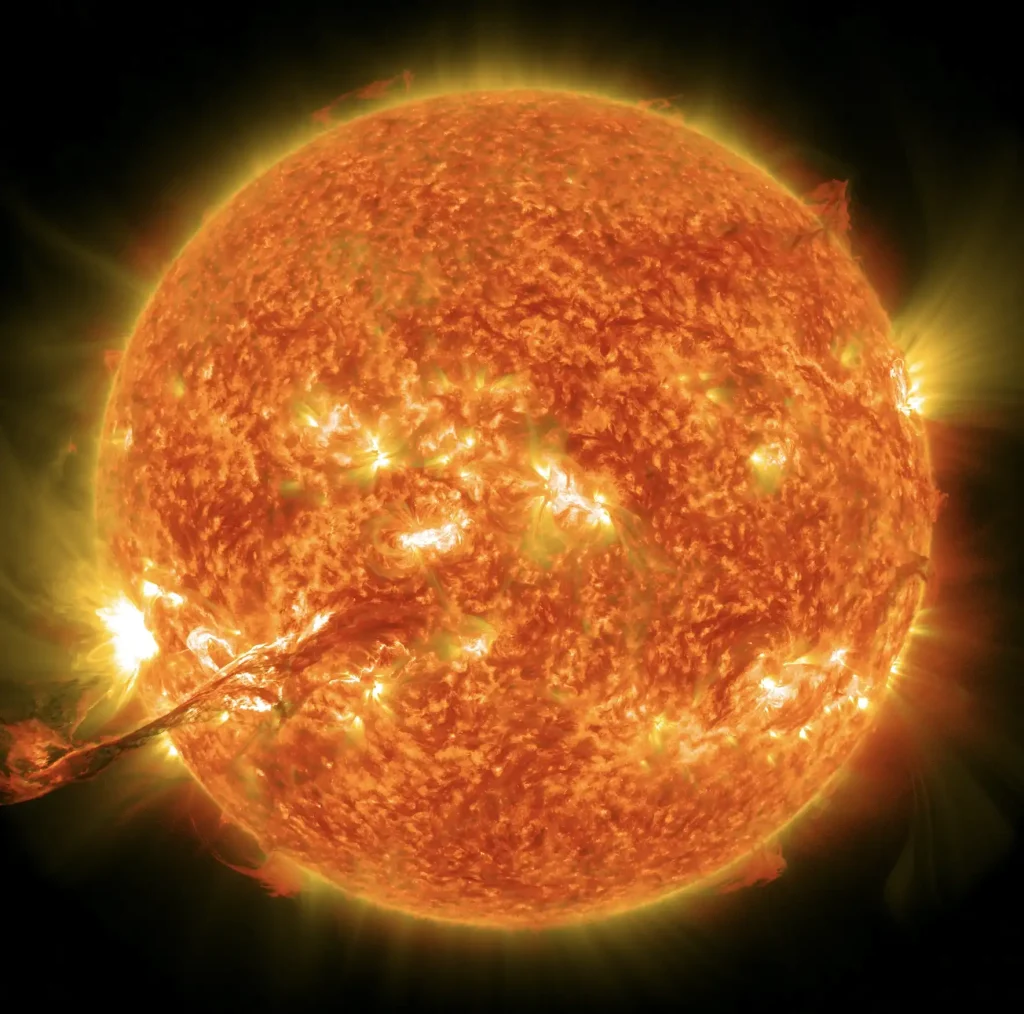How Hot Is The Sun? The Only Explanation You Need
The Sun is a hot ball consisting of energy and glowing gas. The warmth and energy it provides are vital for living things on Earth. The Sun is also the largest object at the center of the solar system.
Measuring the Sun’s temperature seemed impossible in the past. Yet, the advance of technology and science has brought more insights into the Sun. So, how hot is the Sun? I will bring you a detailed explanation in this post.
Read also: How Many Lumens Is The Sun?
- How Hot Is The Sun?
- The Thermal Energy Comes From The Sun’s Core
- The Sun Outer Layers And Surface Feature Lower Temperatures
- The Sun’s Atmosphere Is Very Hot
- How Do Scientists Measure The Sun’s Temperature?
- FAQs
- Is Lava Hotter Than The Sun?
- Why Does The Sun’s Temperature Vary?
- Is There A Fire On The Sun?
- Final Thoughts
How Hot Is The Sun?
The Sun’s temperature at the core ranges around 27 million degrees Fahrenheit (15 million degrees Celsius). Meanwhile, its surface is significantly cooler, with around 10,000 degrees Fahrenheit (5,500 degrees Celsius).
The Thermal Energy Comes From The Sun’s Core

These numbers and measurements were released by NASA. The administration indicates that gravity helps hold the hydrogen inside the Sun’s core. It will result in high pressure within the core and create nuclear fusion.
It’s a process in which the hydrogen atoms within the core collide with each other with a strong force. The nuclear fusion process creates helium.
After a long time, energy will accumulate inside the core and push its temperature to 27 million degrees Fahrenheit. The heat and energy will then radiate toward the surface and outer space.
The Sun Outer Layers And Surface Feature Lower Temperatures
The heat will reduce when it moves further from the core. When it reaches the radiative zone, the temperature ranges from around 12 million °F.
According to Phys.org, there is no thermal energy generated within this layer. The heat transmitted from the core will now get absorbed by the ions. Thus, it may take a long time before the heat can reach the outer surface of the Sun.
After passing the radiative zone, thermal energy will reach the convective zone. The temperature in this area ranges around 4 million °F.
The Sun’s Atmosphere Is Very Hot

The temperature varies significantly between the layers in the surrounding atmosphere. It ranges from around 10,000 °F in the photosphere. Humans can detect radiation in the form of visible Sunlight.
Meanwhile, the darker areas around the Sun are significantly cooler. They range from 5,400 to 8000°F.
However, a strange phenomenon occurs when it comes to the chromosphere. This area lies above the Sun’s surface; the temperature goes up to 3,5 million °F.
This number is about 400 times higher than the temperature measured in the photosphere. Scientists still haven’t explained this strange phenomenon.
How Do Scientists Measure The Sun’s Temperature?

The plasma in the Sun’s atmosphere will gradually remove when it moves further from the object. Most of the light humans receive comes from the photosphere.
Though it’s not a solid surface, the photosphere is still regarded as the Sun’s surface. Meanwhile, a star’s light is closely related to the temperature it emits.
So, scientists can determine the Sun’s temperature by measuring its light. They will watch the wavelength and use models to calculate the temperature.
Another method is to observe the lines of the solar spectrum. These absorption lights can help scientists measure the Sun’s strengths and temperature.
FAQs
Is Lava Hotter Than The Sun?
Lava is fatally hot, with an average temperature of 2,200 °F or even more. Yet, it’s just a grain of sand compared to the Sun’s temperature (around 27 million °F).
Why Does The Sun’s Temperature Vary?
The Sun’s temperature varies based on factors like transport and generation of energy. These factors are completely different between the layers of the object. Thus, it will create different ranges of temperatures between these layers.
Is There A Fire On The Sun?
Though the Sun is extremely hot, it doesn’t burn or create any fire. Instead, it creates thermal energy via the collision of hydrogen particles.
Final Thoughts
In summary, the Sun’s temperature ranges from 10 to a maximum of 27 million °F in its core. Meanwhile, the temperatures measured on its surface and atmosphere are much lower (around 5 to 10 million °F). I hope the answer can help satisfy your curiosity. Thank you for reading!
Hanna is a technical copywriter and editor with a focus on PC, Mac and more at MarsScreen. She is passionate about making technology accessible to everyone, regardless of their level of expertise. When she is not writing or editing, Hanna enjoys painting, and watching sci-fi movies - anything to help her forget the world for a little while.






